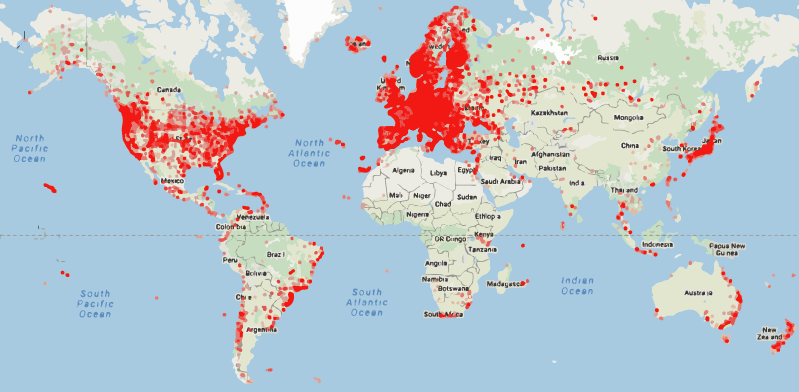Check in from anywhere
Iplivecams makes it easy to check in beaches, cities, pets, landscapes or business from anywhere and makes it easy to stay connected to places worldwide.

IpLiveCams is your gateway to an ever-changing panorama of life in motion
IpLiveCams is a directory of streaming media freely available in the Internet. We do not provide the streaming content. Instead, our aim is to allow Internet users to find various media websites and content more easily. The copyright and ownership of any website or live stream listed on this site remains with the broadcaster.
If you are a live stream or camera owner and object the way it's listed here, please contact us we'll promptly alter or delete it.We use third-party advertising companies to serve ads when you visit our Web site. These companies may use information (not including your name, address email address or telephone number) about your visits to this and other Web sites in order to provide advertisements about goods and services of interest to you.
We use return email addresses solely to respond to the messages we receive. These addresses are not used for any other purpose and are never shared with external parties. If you have any questions or concerns regarding your privacy, please feel free to contact us.

We have the world's largest webcam directory

We grow rapidly by receiving new webcam submissions daily
Network (IP) cameras transmit audio and video data over Ethernet using Internet Protocol, while traditional analog CCTV cameras output analog NTSC/PAL signals over coaxial cable. Each IP camera is a self-contained network device with its own IP address and embedded processor that compresses video (typically using H.264) and encapsulates it into IP packets. IP cameras support high-definition (HD) or higher imaging, built-in analytics, and local storage options like SD cards. Unlike analog systems, which need separate wiring for power and video, IP cameras often use a single cable for both data and power via Power-over-Ethernet (PoE), greatly simplifying installations.
IP camera systems enable full remote control over PTZ (pan-tilt-zoom) functions, configuration settings, and real-time monitoring across LANs, WANs, and even the cloud. Because all communication — including video streams, commands, and alarms — flows over IP networks, operators can monitor and manage multiple geographically dispersed cameras through a centralized video management system (VMS).
Several standard protocols ensure the functionality and interoperability of IP cameras. ONVIF (Open Network Video Interface Forum) is a crucial standard that allows IP cameras and recording systems from different manufacturers to communicate seamlessly. ONVIF defines standardized communication for features like live viewing, PTZ control, recording, and device discovery, often using HTTP and HTTPS protocols.
Real-Time Streaming Protocol (RTSP) is another essential protocol for live camera systems. RTSP controls the initiation and management of streaming sessions between client devices and cameras. Typically operating over TCP port 554, RTSP uses Real-Time Transport Protocol (RTP) over UDP for the actual transport of compressed video streams, ensuring efficient low-latency delivery even in high-resolution formats. Cameras offering RTSP streams allow flexibility for third-party viewing software or integration into custom systems.
H.264, known as Advanced Video Coding (AVC), is the most commonly used video compression standard in IP cameras. By employing inter-frame compression, H.264 significantly reduces the amount of bandwidth and storage space required compared to formats like Motion JPEG (MJPEG), without compromising image quality. H.264 streams can reduce bitrates by up to 80% compared to raw video streams, allowing multiple HD streams to traverse typical Gigabit Ethernet networks without congestion.
Proper installation of IP camera systems is critical for optimal performance. IP cameras are connected to Ethernet switches — ideally Gigabit-capable — via Cat5e or Cat6 cables. Each device requires a unique IP address, assigned either manually (static IP) or dynamically through DHCP reservations. Segregating IP cameras into a dedicated subnet or VLAN ensures better traffic management, security, and system stability.
Most modern IP cameras are powered via PoE, eliminating the need for separate electrical wiring. For installations where additional power is needed, such as with PTZ cameras that require motors, PoE+ (802.3at) or PoE++ (802.3bt) standards provide increased wattage. When the Ethernet cable run exceeds 100 meters, solutions such as fiber optic cabling, PoE extenders, or additional switch points are employed.
Using managed switches is highly recommended. Managed switches allow administrators to enable features like VLANs, Quality of Service (QoS) prioritization for video traffic, and IGMP Snooping for efficient multicast streaming. These settings ensure that video data receives transmission priority over less critical network traffic, maintaining live stream quality even during peak usage times.
IP video traffic can be bandwidth-intensive, and calculating the load per camera and overall system is essential. For example, a 1080p H.264 stream typically uses between 4 to 8 Mbps, depending on compression settings and scene complexity. Higher resolutions like 4K can demand upwards of 15 to 20 Mbps per camera.
Multi-streaming technology enables cameras to output several streams at different resolutions and bitrates simultaneously. Typically, a full-resolution stream is recorded locally, while a lower-resolution sub-stream is used for remote viewing or mobile access to conserve bandwidth. Stream configuration settings such as frame rate, resolution, and bitrate are adjustable to optimize network load and ensure storage efficiency without sacrificing necessary image quality.
Variable Bitrate (VBR) and Constant Bitrate (CBR) encoding options are common in IP cameras. VBR provides better quality during dynamic scenes by adjusting the bitrate as needed, whereas CBR keeps network usage predictable, crucial for network planning and preventing saturation. Systems supporting multicast streaming can efficiently deliver video to multiple viewers simultaneously, reducing bandwidth consumption by sending a single video stream across the network instead of multiple identical unicast streams.
One of the major advantages of IP-based live camera systems is the ability to monitor and control cameras remotely. Accessing cameras securely can be achieved through Virtual Private Networks (VPNs) or cloud-based P2P services. VPNs allow secure, encrypted access to internal network resources, ensuring that IP cameras remain protected from direct exposure to the internet.
Some systems offer mobile apps or web-based portals where users can view live footage, receive push notifications for alarms, and control PTZ functions. Cloud-enabled cameras simplify remote access by automatically establishing encrypted outbound connections to a centralized server, eliminating the need for complex router configurations or port forwarding, which can expose systems to cyberattacks if not carefully secured.
For deployments requiring public internet access, using non-default ports, enabling HTTPS encryption, and setting up strong firewall rules are critical steps. Access control lists (ACLs) and user authentication management help ensure that only authorized individuals can interact with the live camera system.
Like any network-connected device, IP cameras introduce security risks if not properly managed. Weak default passwords, outdated firmware, and unsecured network services are some of the common vulnerabilities. Attackers can exploit these weaknesses to gain unauthorized access to video feeds, manipulate camera settings, or use compromised devices as entry points into broader networks.
Mitigating these risks starts with basic cybersecurity hygiene: changing all default passwords to strong, unique ones, keeping firmware updated, disabling unused services, and applying encryption wherever possible. Using HTTPS for web interfaces, secure ONVIF profiles, and encrypted RTSP streams (via RTSPS) can significantly reduce the risk of interception or manipulation of video data.
Network segmentation also plays a vital role. Isolating IP cameras on a separate VLAN with strict firewall rules limits the exposure of these devices to internal threats. Monitoring network traffic for unusual behavior, implementing access logs, and deploying intrusion detection systems can further enhance security. Physical security measures such as tamper-resistant housings and surge protection should also be considered in outdoor or vulnerable environments.
System administrators should maintain an inventory of all IP cameras and related devices, regularly audit access logs, and enforce strict user role permissions, allowing only necessary access to different system functions. Regular security assessments, vulnerability scanning, and penetration testing ensure that the surveillance network remains resilient against evolving threats.
New Tip: Always configure IP cameras to send real-time alerts (e.g., email or SMS) when specific motion detection or analytics rules are triggered; this can drastically improve incident response time.
Interesting Fact: The first IP camera, developed in 1996, was created by Axis Communications and was called the AXIS NetEye 200, setting the foundation for modern network-based surveillance systems!
Millions of viewers around the world!
Across the globe, the world's foremost hotels, renowned tourism boards, and iconic attractions rely on IpLiveCams to broadcast the allure of their destinations in real time. By showcasing breathtaking views and capturing every magical moment as they unfold, our technology enables these industry leaders to create captivating image and video content around the clock.
Imagine discovering spellbinding vistas, experiencing serene sunsets, and watching weather transformations from the comfort of your home. With IpLiveCams, you can explore some of the most stunning locations on Earth as if you were there, immersing yourself in the unique ambience and energy of each place. Whether you're planning your next getaway or simply yearning for a virtual escape, our live streaming service delivers the next best thing to experiencing these incredible destinations in person.

Iplivecams makes it easy to check in beaches, cities, pets, landscapes or business from anywhere and makes it easy to stay connected to places worldwide.
Dozens of live streams let you check in on kitty or puppy or cams, take a look at surf conditions, weather and more! From live streaming restaurant kitchens, to animal shelters, to small business store fronts.
Iplivecams makes it easy to stay connected to people, places and pets, no matter where you are. From live streaming puppies, to backyard wildlife, to life in the zoo.
From live streaming studios, to events and more, check out more of Iplivecams's streaming feeds. From live streaming beach front views, to city skylines, to locations from around the world.